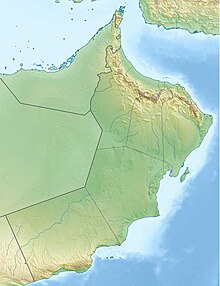Ubar
Coordinates: 18 ° 15 ′ 16 ″ N , 53 ° 39 ′ 1 ″ E
As Ubar is a historically traditional name an ancient city in Oman designated in 1992 by English adventurer Ranulph Fiennes was discovered. It was probably destroyed by an earthquake between 300 and 500 AD, i.e. in a phase of progressive desertification . However, it is unclear whether the name Ubar denoted a city or rather a tribe or region.
Since the 1930s, the region has been looking for a city sunken in the sand. The researcher Nicholas Clapp would like to equate Ubar with the "columnar city" Iram , about the destruction of which the Koran reports. On a map from the 2nd century, Claudius Ptolemy recorded a place in this region called Omanum Emporium , i.e. a trading and customs post. Alternatively, it is also assumed that the submerged place is identical to the old Wabar .
Todays situation
There are still some ruins of ancient Ubar that can be reached by four-wheel drive car. However, parts of the area collapsed as underground water veins made the overburden fragile. Today these water veins supply a small place in the immediate vicinity of the ruins, in which many finds, old photographs of the excavations and some satellite images including the elaboration of the assumed earlier trade routes are exhibited in a small museum .
literature
- Ranulph Fiennes: Atlantis of the Sands: The Search for the Lost City of Ubar. 1993, ISBN 0451175778
- Nicholas Clapp: The City of Fragrances: In search of the Atlantis of the desert. Berlin: Rütten and Loening 1999, ISBN 3-352-00624-5




